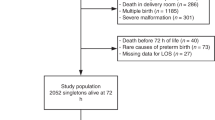Abstract
Background Cisapride is a possible cause of potentially life threatening QT prolongation.
Aims We investigated these cardiac side effects in premature infants, mainly in relation to fetal growth.
Patients Forty six preterms (mean birth weight 1.350 g, mean post conceptional age 31 weeks) were studied. Thirty one of them were appropriate for gestational age (AGA) and 15 were small for gestational age (SGA). Cisapride was randomly administered at a 0.3 mg/kg or 0.6 mg/kg daily dose. Fifty preterms (15 SGA/35 AGA) not treated with Cisapride were used as control group.
Methods A pre-treatment ECG was performed and the QT-corrected (Bazzet’s formula) intervals were compared with the in-treatment values (normal values ≤440 mseconds). In the control group two different ECG were performed with a timing similar to the treated group (mean interval 5 days).
Results and Conclusions No patients showed clinical evidence of drug toxicity. In the small for gestational age group, both baseline QTc (mean 397; range 370–420 ms) and in-treatment QTc (mean 410 range 360–500 ms) were significantly higher than those found in the appropriate for gestational age group (mean 386, range 360–420 ms; mean 396, range 370–420 ms, respectively). This difference was found also in the first ECG of the control group. Moreover the mean QTc lengthening during treatment was significantly higher in small for gestational age group than in the appropriate for gestational age group.
Three infants showed a rise in the QTc interval above the value of 440 ms and all were SGA (p = 0.03). No significant correlation was found between birth weight or gestational age and the change in QTc values during Cisapride treatment in the appropriate for gestational age group. Intrauterine growth retardation is a major risk factor for Cisapride-induced QT prolongation in preterm infants.
Similar content being viewed by others
Abbreviations
- NICU:
-
neonatal intensive care units
- QTc:
-
QT-corrected
- ECG:
-
electrocardiogram
- SGA:
-
small for gestational age
- AGA:
-
appropriate for gestational age
- CYP3A4:
-
isoform 3A4 of the cytochrome P-450
References
Enriquez A, Bolisetty S, Patole S, Garvey PA, Campbell PJ. Randomised controlled trial of Cisapride in feed intolerance in preterm infants. Arch Dis Child Fetal Neonatal Ed 1998;79:F110–F113.
Kimball AL, Carlton DP. Gastroesophageal reflux medications in the treatment of apnoea in premature infants. J Pediatr 2001;138:355–360.
Ward RM, Lemons JA, Molteni RA. Cisapride: A survey of the frequency of use and adverse events in premature newborns. Pediatrics 1999;103:469–472.
Wysowski DK, Bacsanyi J. Cisapride and fatal arrhythmia. N Engl J Med 1996;335:290–291.
Lewin MB, Bryant RM, Fenrich AL, Griffa RG. Cisapride-induced long QT interval. J Pediatr 1996;128:279–281.
Bernardini S, Semama DS, Huet F, Sgro C, Gouyon JB. Effects of Cisapride on QTc interval in neonates. Arch Dis Child 1997;77:F241–F243.
Hamill PV, Drizd TA, Johnson CL, Reed RB, Roche AF, Moore WM. Physical growth: National Center for Health Statistics percentiles. Am J Clin Nutr 1979;32:607–629.
Tonini M, De Ponti F, Di Nucci A, Crema F. Review article: Cardiac adverse effects of gastrointestinal prokinetics [review]. Aliment Pharmacol Ther 1999;13:1585–1591.
Drolet B, Khalifa M, Deleau P, Hamelin BA, Turgeon J. Block of the rapid component of the delayed rectifier potassium current by the prokinetic agent Cisapride underlies drug-related lengthening of the QT interval. Circulation 1998;97:204–210.
Vandenplas Y, Belli DC, Benatar A, et al. The role of Cisapride in treatment of paediatric gastroesophageal reflux. J Pediatric Gastroent Nutr 1999;28:518–528.
Dubin A, Kikkert M, Mirmiran M, Ariano R. Cisapride associated with QTc prolongation in very low birth weight preterm infants. Pediatrics 2001;107:1313–1316.
Wang L, Feng ZP, Kondo CS, Sheldon RS, Duff HJ. Developmental changes in the delayed rectifier K channel in mouse heart. Circ Res 1996;79:79–85.
Wang L, Duff HG. Identification and characteristic of the delayed rectifier K current in fetal mouse ventricular myocytes. Am J Physiol 1996;270:H2088–H2093.
Lacroix D, Sonnier M, Moncion A, Cheron G, Cresteil T. Expression of CYP3A in human liver: evidence that the shift between CYP3A7 and CYP3A4 occurs immediately after birth. Eur J Biochem 1997;247:625–634.
Horsmans Y. Major cytochrome P-450 families: Implications in health and liver disease. Acta Gastroenetrol Belg 1997;60:2–10.
Cools F, Benatar A, Bruneel E, et al. A comparison of the pharmacokinetics of two dosing regimens of cisapride and their effects on corrected QT interval in premature infants. Eur J Clin Pharmacol 2003;59:17–22.
Bergman JW, Human DE, Moor MMA, Schulz JM. Effect of kwashiorkor on the cardiovascular system. Arch Dis Child 1988;63:1359–1362.
Thwaites BC, Bose M. Very low calorie diets and pre-fasting prolonged QT interval. A hidden potential danger. West Indian Med J 1992;41:169–171.
Fuenmayor AJ, Mora RE, Fuenmayor AC, Fuenmayor AM. QT-interval dispersion in malnourished children. Clin Cardiol 1998;21:201–205.
Cunha DF, Cunha SF, Ferreira TP, et al. Prolonged QTc intervals on the electrocardiograms of hospitalised malnourished adults. Nutrition 2001;17:370–372.
Cooke RA, Chambers JB, Singh R, et al. QT interval in anorexia nervosa. Br Heart J 1994;72:69–73.
Widmark C, Jansson T, Lindecrantz K, Rosen KG. ECG waveform, short term heart rate variability and plasma catecholamine concentration in response to hypoxia in intrauterine growth retarded guinea-pig fetuses. J Dev Physiol 1991;15:161–163.
Massin MM, Withofs N, Maeyns K, Ravet F. The influence of fetal and postnatal growth on heart rate variability in young infants. Cardiology 2001;95:80–83.
Author information
Authors and Affiliations
Corresponding author
Rights and permissions
About this article
Cite this article
Corvaglia, L., Faldella, G., Rotatori, R. et al. Intrauterine Growth Retardation is a Risk Factor for Cisapride-Induced QT Prolongation in Preterm Infants. Cardiovasc Drugs Ther 18, 371–375 (2004). https://doi.org/10.1007/s10557-005-5061-0
Issue Date:
DOI: https://doi.org/10.1007/s10557-005-5061-0




